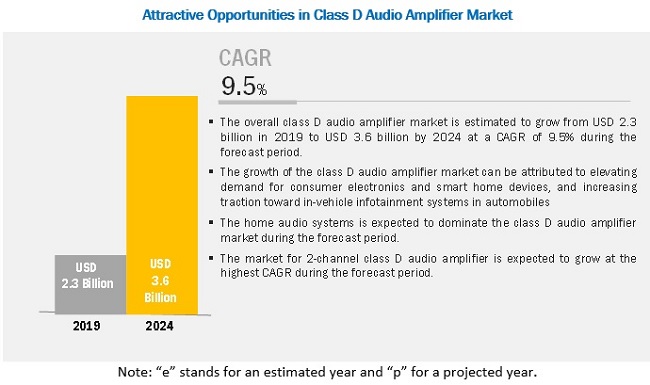The class D audio amplifier market is expected to reach USD 3.6 billion by 2024 from USD 2.3 billion in 2019 at a CAGR of 9.5%. The growth of the class D audio amplifier market can be attributed to the increasing demand for consumer electronics and smart home devices, increasing traction toward in-vehicle infotainment systems in automobiles, and rise in demand for energy-efficient technologies or components in portable and compact devices. Moreover, the escalating popularity of in-vehicle infotainment systems is expected to create huge growth opportunities for the class D audio amplifier providers.

Download PDF Brochure @
https://www.marketsandmarkets.com/pdfdownloadNew.asp?id=1363272
The consumer electronics industry is expected to hold a larger share of the class D amplifier market during the forecast period. These amplifiers have high power efficiency; this makes it ideal for the use in various electronic devices, such as entertainment devices including smartphones, wireless speakers, desktops, laptops, tablets, television sets, home audio systems, and soundbars.
The 2-channel audio amplifiers accounted for a majority share of the overall market in 2018. This type is popularly used in car audio systems and smartphones. These amplifiers are also used in basic car stereo systems to power left and right front stereo speakers and matching rear speakers. Apart from this, it is also used in home entertainment systems and consumer electronic devices. A few of the manufacturers of 2-channel class D audio amplifiers are Infineon Technologies AG (Germany), ICEpower A/S (Denmark), Texas Instruments (US), and Cirrus Logic (US).
RoW is expected to be the fastest-growing region in the global the class D audio amplifier market during the forecast period, and the projected growth of this market is attributed to the rising investments in the automotive sector in Israel, the Middle East, and North Africa, which is driving the adoption of new technologies such as class D audio amplifiers in this industry. Additionally, there is a significant growth in the Internet connections on devices such as smartphones, smart speakers, smart televisions, and home audio systems. Growing connectivity and smartphone penetration further strengthen the demand for class D audio amplifiers in this region.
